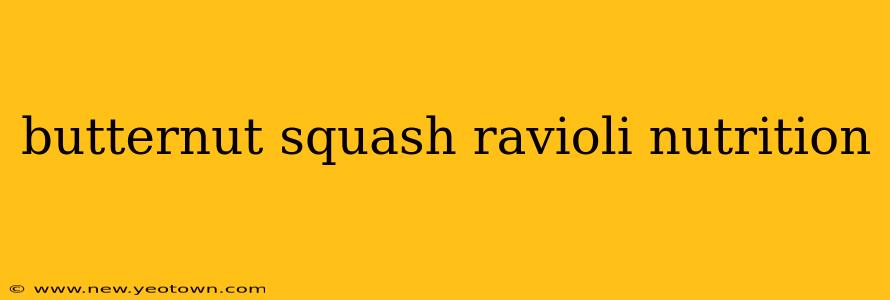Butternut squash ravioli. The mere mention conjures images of warm, comforting pasta pockets filled with a vibrant, sweet squash filling, often bathed in a creamy brown butter sage sauce. But beyond the delightful taste, lies a surprisingly nutritious meal. Let's delve into the nutritional profile of this autumnal favorite and uncover why it’s more than just a delicious indulgence.
What are the main nutritional benefits of butternut squash ravioli?
The nutritional benefits of butternut squash ravioli stem primarily from two key components: the butternut squash itself and the pasta. Butternut squash is packed with essential vitamins and minerals. It's an excellent source of Vitamin A (in the form of beta-carotene), Vitamin C, potassium, and fiber. These nutrients contribute to a healthy immune system, improved digestion, and overall well-being. The pasta, while contributing carbohydrates for energy, also provides some protein depending on the type of flour used. However, the overall nutritional profile is significantly influenced by the recipe and ingredients used. A ravioli dish laden with heavy cream and butter will have a drastically different nutritional profile than one made with a lighter sauce.
How many calories are in a serving of butternut squash ravioli?
This is where things get tricky. The calorie count can fluctuate wildly depending on the serving size, the type of pasta (whole wheat vs. semolina), the richness of the filling, and, most significantly, the sauce. A single serving of restaurant-prepared butternut squash ravioli could easily range from 300 to 600 calories or more. Homemade versions, often lighter and with more control over ingredients, can be significantly lower. It's crucial to be mindful of portion sizes and consider the ingredients when assessing the calorie content.
Is butternut squash ravioli good for weight loss?
The answer isn't a simple yes or no. Butternut squash ravioli can be part of a weight-loss diet, but it requires mindful consumption. The high fiber content in butternut squash promotes satiety, which can aid in weight management. However, the calorie density can be high, especially with creamy sauces. Choosing whole wheat pasta and a lighter sauce, such as a simple brown butter or a light sage-infused olive oil, will significantly reduce the overall calorie and fat content. Portion control is also essential. A smaller serving of a higher-quality ravioli dish is far preferable to a large serving of a less nutritious one.
What are the potential downsides of eating butternut squash ravioli?
While generally healthy, there are some potential downsides to consider. Individuals with gluten intolerance need to ensure the pasta is gluten-free. The high carbohydrate content might not be ideal for those following very low-carb diets. Additionally, the calorie count, as mentioned, can be substantial, particularly with rich sauces and generous portions. Finally, the sodium content can be high depending on the recipe, so individuals watching their sodium intake should be cautious.
Is butternut squash ravioli a healthy choice?
The healthiness of butternut squash ravioli ultimately depends on the specific recipe and preparation. When made with whole wheat pasta, a moderate amount of filling, and a lighter sauce, it can be a relatively healthy and satisfying meal. It offers a good source of vitamins, minerals, and fiber. However, it's crucial to be aware of portion sizes and the potential for high calorie and fat content, particularly when using richer sauces and ingredients. A balanced approach, considering the overall dietary intake, is key. Think of it as a treat to be enjoyed occasionally as part of a varied and nutritious diet rather than a staple food. Making it at home allows for complete control over the ingredients, leading to a healthier and more satisfying outcome.

